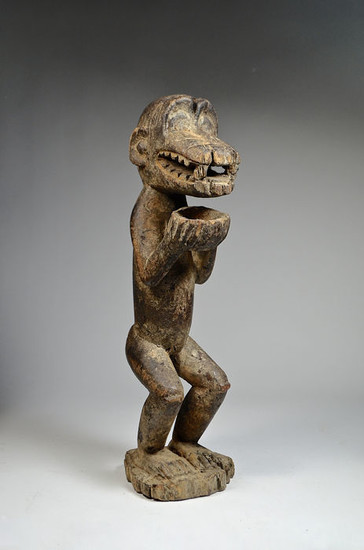Mbra cult monkey figure - Wood - GBEKRE - Baoulé - Ivory Coast
Provenance: - Giovanni Franco Scanzi, Italy - Private collection, UK - David Malik African Art Gallery, London, UK Giovanni Scanzi published several books on African art : L'art traditional Lobi; Statuaire de Cote Ivoire, etc Exhibited: - Tribal Art London, 2019 Published: - David Malik African Art calague for the Tribal Art London 2019, page 36-37 These awe-inspiring bowl-bearing figures evoke invisible powers and serve their communities through the mediation of diviners. The Baule have monkey figures commonly used for the "Mbra" cult that more or less resemble each other. Endowed with prognathic jaw and sharp teeth and a granular patina resulting from sacrifices, the monkey holds a bowl or a pestle in its paws that was used to hold an egg. Sources differ on its role or function: some say it intervenes in the ritual of divination, others that it is a protection against sorcerers, or a protective divinity of agrarian rites, or a bush spirit. Owned only by trance diviners and certain families, the figure resides hidden outside under a shelter. The sculpture is said to feed on sacrifices brought from the bush and poured all over the figure, leaving it filthy and encrusted. "Baule Monkeys are powerful objects, which are forbidden to be seen in public display. Monkey figures share stylistic features with the mens´s sacred masks, and have some of the qualities of secrecy and danger to women. They combine animal and human traits in such way that it is nearly impossible to separate them, and they have the prominent teeth and boxy muzzle typical of the masks. Both also receive sacrifical offerings directly on the sculpture, and are associated with the bush. Mbra monkey figures, for example are kept in the village, but "fed" with sacrifices in the bush. " Susan Vogel, 1997: 238 "In Baule culture, cupbearing monkey statues, commonly known as "gbekre" since their first mention in 1900 by Maurice Delafosse, belong to the category of amwin, or "objects of power". They were used by men-only initiation societies for a number of purposes, both functional – as a basis for prophylactic practices, linked to agrarian rites or to a form of divination known as mbra (Bouloré in RMN, 2000: 107 et Vogel, 1997: 221-230) – and iconographic, each type being designated by a specific term (aboya, mbotumbo, ndyadan, gbekre. . .) . " The sculpture will be shipped via DHL Express with track and trace, fully insured. 1-3 days delivery within Europe. 2-4 days delivery to USA.
[ translate ]View it on
Sale price
Estimate
Time, Location
Auction House
Provenance: - Giovanni Franco Scanzi, Italy - Private collection, UK - David Malik African Art Gallery, London, UK Giovanni Scanzi published several books on African art : L'art traditional Lobi; Statuaire de Cote Ivoire, etc Exhibited: - Tribal Art London, 2019 Published: - David Malik African Art calague for the Tribal Art London 2019, page 36-37 These awe-inspiring bowl-bearing figures evoke invisible powers and serve their communities through the mediation of diviners. The Baule have monkey figures commonly used for the "Mbra" cult that more or less resemble each other. Endowed with prognathic jaw and sharp teeth and a granular patina resulting from sacrifices, the monkey holds a bowl or a pestle in its paws that was used to hold an egg. Sources differ on its role or function: some say it intervenes in the ritual of divination, others that it is a protection against sorcerers, or a protective divinity of agrarian rites, or a bush spirit. Owned only by trance diviners and certain families, the figure resides hidden outside under a shelter. The sculpture is said to feed on sacrifices brought from the bush and poured all over the figure, leaving it filthy and encrusted. "Baule Monkeys are powerful objects, which are forbidden to be seen in public display. Monkey figures share stylistic features with the mens´s sacred masks, and have some of the qualities of secrecy and danger to women. They combine animal and human traits in such way that it is nearly impossible to separate them, and they have the prominent teeth and boxy muzzle typical of the masks. Both also receive sacrifical offerings directly on the sculpture, and are associated with the bush. Mbra monkey figures, for example are kept in the village, but "fed" with sacrifices in the bush. " Susan Vogel, 1997: 238 "In Baule culture, cupbearing monkey statues, commonly known as "gbekre" since their first mention in 1900 by Maurice Delafosse, belong to the category of amwin, or "objects of power". They were used by men-only initiation societies for a number of purposes, both functional – as a basis for prophylactic practices, linked to agrarian rites or to a form of divination known as mbra (Bouloré in RMN, 2000: 107 et Vogel, 1997: 221-230) – and iconographic, each type being designated by a specific term (aboya, mbotumbo, ndyadan, gbekre. . .) . " The sculpture will be shipped via DHL Express with track and trace, fully insured. 1-3 days delivery within Europe. 2-4 days delivery to USA.
[ translate ]


